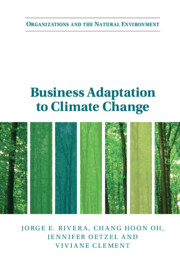Book contents
- Business Adaptation to Climate Change
- Organizations and the Natural Environment
- Business Adaptation to Climate Change
- Copyright page
- Dedication
- Epigraph
- Contents
- Figures
- Tables
- About the Authors
- Foreword
- Preface and Acknowledgments
- Publication Acknowledgments
- Part I Introduction
- Part II Conceptual Framework
- Part III Empirical Studies of Business Adaptation to Nature Adversity
- Part IV Conclusions
- Bibliography
- Index
- References
Bibliography
Published online by Cambridge University Press: 28 April 2022
- Business Adaptation to Climate Change
- Organizations and the Natural Environment
- Business Adaptation to Climate Change
- Copyright page
- Dedication
- Epigraph
- Contents
- Figures
- Tables
- About the Authors
- Foreword
- Preface and Acknowledgments
- Publication Acknowledgments
- Part I Introduction
- Part II Conceptual Framework
- Part III Empirical Studies of Business Adaptation to Nature Adversity
- Part IV Conclusions
- Bibliography
- Index
- References
- Type
- Chapter
- Information
- Business Adaptation to Climate Change , pp. 249 - 272Publisher: Cambridge University PressPrint publication year: 2022



